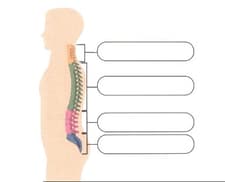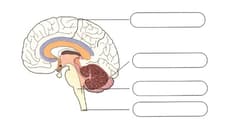MEDIUM
7th ICSE
IMPORTANT
Earn 100
What is a neuron? Draw a labelled diagram of a neuron. What is a synapse? What happens at the synapse between two neurons?

Important Questions on The Nervous System
HARD
7th ICSE
IMPORTANT
Label the different parts of the vertebral column.
MEDIUM
7th ICSE
IMPORTANT
Label the different parts of human brain
MEDIUM
7th ICSE
IMPORTANT
What is P? Name five organs which contain cells (or group of cells) like P.
EASY
7th ICSE
IMPORTANT
Name the nerves Q.
MEDIUM
7th ICSE
IMPORTANT
What is R? Give two examples of R.
EASY
7th ICSE
IMPORTANT
Name nerves S.
MEDIUM
7th ICSE
IMPORTANT
How do messages travel through the nerves Q and S?
HARD
7th ICSE
IMPORTANT
Match the following column
| a. Also known as self-governing nervous system. | 1. Medulla Oblongata | i. It receives information from the surroundings, processes it, interprets it and then responds accordingly. |
| b. Its cell body is like a typical animal cell which contains cytoplasm and a nucleus. | 2. Cerebellum | ii. It emerges from the base of the brain and joins the spinal cord. |
| c. It is the control system for all our actions, thinking and behaviour. | 3. Spinal cord | iii. Coordinates smooth body movements such as walking and dancing. |
| d. As many as 31 pairs of nerves arise from it. | 4. Neuron | iv. Controls the activities of the organs inside our body automatically even without our thinking about them. |
| e. A small egg-shaped part under the cerebrum at the back of the head. | 5. Autonomic nervous system | v. Its structure is specially adapted to be able to carry messages over large distances in the body. |
| f. It is also the controlling centre for reflexes such as swallowing, coughing and sneezing. | 6. Nervous system | vi. It begins in continuation with medulla and extends downwards. |


